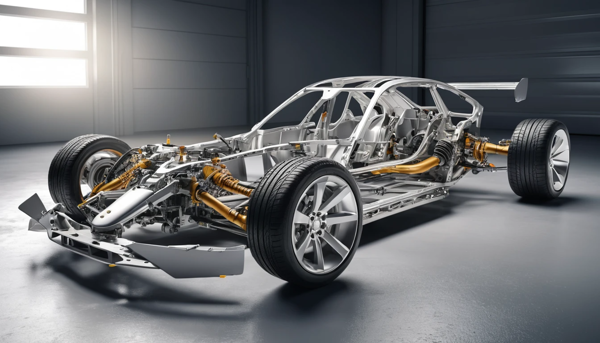Symptoms of worn out struts include uneven tire wear, poor steering, and clunky noises. Learn the signs before it gets worse.
Symptoms of Worn Out Struts – Key Signs You Shouldn’t Ignore
Is your car bouncing more than usual or making odd clunking noises over bumps? 🤔 You might be dealing with worn out struts. This is a silent issue that can harm your car’s performance and your safety.
Struts are very important for your car’s suspension system. When they start to fail, the signs might sneak up on you. But the problems can be serious. Let’s look at what worn out struts really look and feel like.
🚗 What Are Struts, Anyways?
Struts are part of your car’s suspension system. They absorb shocks from the road and keep your tires in touch with the pavement.
They have several parts:
- The shock absorber
- A coil spring
- A structural housing unit
Without good struts, your ride gets uncomfortable, unsafe, and unpredictable.
🎯 Main Purpose of Struts
Struts help your vehicle:
- Handle smoothly on turns
- Brake safely without nose-diving
- Maintain consistent wheel alignment
- Keep tires from wearing out too quickly
So when struts wear out, all of these systems get worse.
🔊 Clunking Noises Over Bumps
Hear weird noises when going over speed bumps or potholes?
That clunking or knocking sound could be your struts bottoming out. It means the parts inside are worn.
Don’t ignore this. It means your car is not absorbing road impact well.
⚖️ Uneven Tire Wear
Bad struts can’t hold the tire flat to the road. This causes uneven tread wear, like cupping (a scalloped pattern).
Here’s how worn struts affect your tires:
| Symptom | Tire Impact | Resulting Risk |
|---|---|---|
| Cupped Tread | Poor road contact | Skidding, blowouts |
| Uneven Shoulder Wear | Misaligned suspension | Loss of grip on turns |
| Fast Tread Erosion | Extra tire bouncing | Shortened tire lifespan |
If your tires are wearing unevenly, the struts might be to blame.
🚘 Excessive Bouncing After Bumps
A healthy car should bounce once after a bump.
If yours keeps bouncing 2–3 times, your struts are likely shot.
Try this test: Push down firmly on the hood or trunk. If it keeps bouncing when you let go, it’s time to check those struts.
🛞 Nose-Diving While Braking
Does your car dip forward hard when braking?
That’s called nose-diving, and it’s a clear sign of worn out front struts. Your car shouldn’t dramatically lean during sudden stops.
This not only feels unstable but also:
- Increases stopping distance
- Reduces control during emergency braking
- Wears brakes unevenly
🌀 Poor Steering Response
If your steering feels loose or delayed, your struts might be at fault.
Bad struts affect your suspension geometry. This can make turning feel unstable or off-center.
It’s not just uncomfortable—it’s unsafe.
🛑 Car Pulls to One Side
Do you feel like your car wants to drift left or right?
This could be caused by:
- Struts worn more on one side
- Misaligned suspension
- Uneven spring tension
While alignment issues can be the cause, don’t overlook struts as the root problem.
🔥 Burning Smell After Driving
Failing struts can overwork nearby components, like brakes and tires, causing heat buildup.
If you notice a hot or burning smell, it might not be your engine—it could be your overworked suspension system.
⚙️ Leaking Hydraulic Fluid
Struts use hydraulic fluid to absorb impact. If you spot oily residue around the base of your struts, it’s likely they’re leaking.
This is a red flag. Without fluid, struts lose their dampening ability.
🚧 Rough or Bumpy Ride
When your struts wear out, they lose their ability to cushion your ride. You’ll feel every:
- Bump
- Crack
- Pebble
If your once-smooth car now rides like a go-kart on gravel, your struts are likely failing.
🧭 Instability at High Speeds
Struts stabilize your vehicle. Without them, body roll and sway become dangerous—especialy on highways.
Watch for:
- Excessive leaning during lane changes
- Nervous handling over 60 mph
- Wobbly steering wheel at cruising speeds
🔍 Visible Rust or Damage
Give your struts a visual inspection.
Look for:
- Rusty springs
- Cracks in the housing
- Broken mounts
Physical damage means internal components are likely compromised.
| Visual Sign | Likely Problem | Urgency Level |
| Leaking fluid | Hydraulic failure | High 🚨 |
| Rusted coil spring | Weakening suspension system | Medium ⚠️ |
| Bent strut housing | Structural damage | High 🚨 |
Don’t wait for complete failure.
🔁 Longer Braking Distances
You may not notice this immediately, but over time worn struts lead to longer stops.
Why?
- Less tire-to-road contact
- More forward vehicle pitch
- Less control on sudden braking
If you’re taking longer to stop, inspect the struts along with the brakes.
🌧️ Poor Performance in Rain or Snow
Bad struts = bad traction.
In wet or icy conditions, worn struts struggle to keep your tires grounded. This increases the risk of:
- Hydroplaning
- Skidding
- Slower reaction time
Stay safe—don’t underestimate the role of struts in slippery weather.
🔄 Vehicle Sways on Turns
If your car leans too much in corners, it’s a sign. The struts aren’t balancing the weight properly.
This can lead to:
- Loss of control
- Passenger discomfort
- Dangerous rollovers at higher speeds
🔧 When to Replace Worn Struts
Here are signs it’s time to replace them:
- 50,000–100,000 miles driven
- Regular clunking or bouncing
- Leaks or visible damage
- Failing performance in bad weather
Don’t delay—driving on worn struts is a safety hazard.
| Replacement Cost | Range (U.S.) | What’s Included |
| Per Strut | $150–$400 | Part only |
| Labor | $100–$300 | Per strut |
| Full Set | $600–$1,200 | Parts + Labor (2 front, 2 rear) |
✅ Final Thoughts: Don’t Overlook the Warning Signs
Your struts may not scream for help, but they definitely show signs when they’re going bad.
Look for:
- Clunky sounds 🚧
- Bouncy rides
- Uneven tires
- Poor handling
Replacing them early keeps your car safe, comfortable, and road-ready. 🚗💨
FAQs
What are early symptoms of worn out struts?
You might notice clunking sounds, tire cupping, or more bounce after bumps.
How can I test struts at home easily?
Push down on the hood or trunk. If it bounces more than once, struts might be worn.
Can bad struts cause steering wheel shake?
Yes, failing struts can create uneven contact with the road, causing vibrations.
Is it dangerous to drive with bad struts?
Absolutely. It affects braking, turning, and tire grip—making your car unsafe.
Do struts need replacing in pairs?
Yes, always replace struts in pairs (both front or both rear) to keep balance.
https://www.familyhandyman.com/project/symptoms-of-bad-shocks-and-struts/
https://www.autoblog.com/article/bad-struts-signs/
https://www.cars.com/articles/when-should-you-replace-shocks-and-struts-1420680995970/






